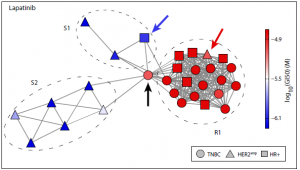Publication Summary
Profiles of Basal and Stimulated Receptor Signaling Networks Predict Drug Response in Breast Cancer Lines
Mario Niepel1*, Marc Hafner1*, Emily A. Pace2*, Mirra Chung1, Diana H. Chai2, Lili Zhou1, Birgit Schoeberl2, and Peter K. Sorger1
1 HMS LINCS Center, Harvard Medical School, Boston, MA; 2 Merrimack Pharmaceuticals, Cambridge, MA
Sci Signal (2013) 6, ra84.
doi:10.1126/scisignal.2004379 / PMID:24065145 / PMCID:PMC3845839
Synopsis
Profiling of receptor tyrosine kinases in cancer cell lines uncovers the diversity of signaling deregulation in cancer, even within cells with the same clinical subtype. In combination with the mutational status and clinical subtypes of the cell lines, these data can be used to predict the cell’s response to therapeutic small molecule inhibitors.
Key findings
- Using linear regression analysis of measurements of the protein and phosphorylation levels of key receptor tyrosine kinases and of the immediate early response to growth factors and cytokines in a panel of breast cancer cell lines, we were able to predict the cell’s response to therapeutic drugs.
- The response to HRG or the combined levels of ErbB2/ErbB3 are predictive of the response to drugs targeting the PI3K/Akt pathway.
- Segregating cells by mutational status or clinical subtype improves predictions, suggesting the possibility of hybrid biomarkers to inform treatment decisions for patients.
Abstract
Identifying factors responsible for variation in drug response is essential for the effective use of targeted therapeutics. We profiled signaling pathway activity in a collection of breast cancer cell lines before and after stimulation with physiologically relevant ligands, which revealed the variability in network activity among cells of known genotype and molecular subtype. Despite the receptor-based classification of breast cancer subtypes, we found that the abundance and activity of signaling proteins in unstimulated cells (basal profile), as well as the activity of proteins in stimulated cells (signaling profile), varied within each subtype. Using a partial least-squares regression approach, we constructed models that significantly predicted sensitivity to 23 targeted therapeutics. For example, one model showed that the response to the growth factor receptor ligand heregulin effectively predicted the sensitivity of cells to drugs targeting the cell survival pathway mediated by PI3K (phosphoinositide 3-kinase) and Akt, whereas the abundance of Akt or the mutational status of the enzymes in the pathway did not. Thus, basal and signaling protein profiles may yield new biomarkers of drug sensitivity and enable the identification of appropriate therapies in cancers characterized by similar functional dysregulation of signaling networks.
Explore the data
We encourage readers to explore the findings and the data underlying this study through the associated project exploration website, which presents a customizable scatterplot browser for visualizing the data. Through the links below, readers also can access datasets containing the raw images, biochemical assay data, and calculated metrics underlying this study, as well as the software for the scatterplot browser.
Available data and software
| Data | Basal profile of receptor tyrosine kinase signaling network measured by ELISA (HMS Dataset #20137). | Details | Download (.xlsx) |
| Data | Cell signaling response to growth factors measured by high-throughput microscopy (HMS Dataset #20138). | Details | Download (.xlsx) |
| Data | Cell signaling response to cytokines measured by high-throughput microscopy (HMS Dataset #20139). | Details | Download (.xlsx) |
| Data | Cell signaling response to growth factors measured by ELISA (HMS Dataset #20140). | Details | Download (.xlsx) |
| Data | Transformed datasets used for drug predictions. | Details | Download (.xlsx) |
| Data | Drug response data from Heiser et al. (2012) PNAS 109(8), 2724–2729. doi: 10.1073/pnas.1018854108 | Download (.xlsx) | |
| Software | A link to our HMS LINCS GitHub for access to the code underlying the interactive scatterplot browser available on the associated project exploration website. | hmslincs at GitHub |
Funding sources
NIH LINCS grant U54 HG006097; NIH grant CA112967 (acquisition of the ICBP43 cell line collection); Stand Up to Cancer grant AACR-SU2C-DT0409; and a fellowship from the Swiss National Science Foundation (PBELP3_140652) to MH. In-kind support for EAP, DHC, and BS was supplied by Merrimack Pharmaceuticals.
